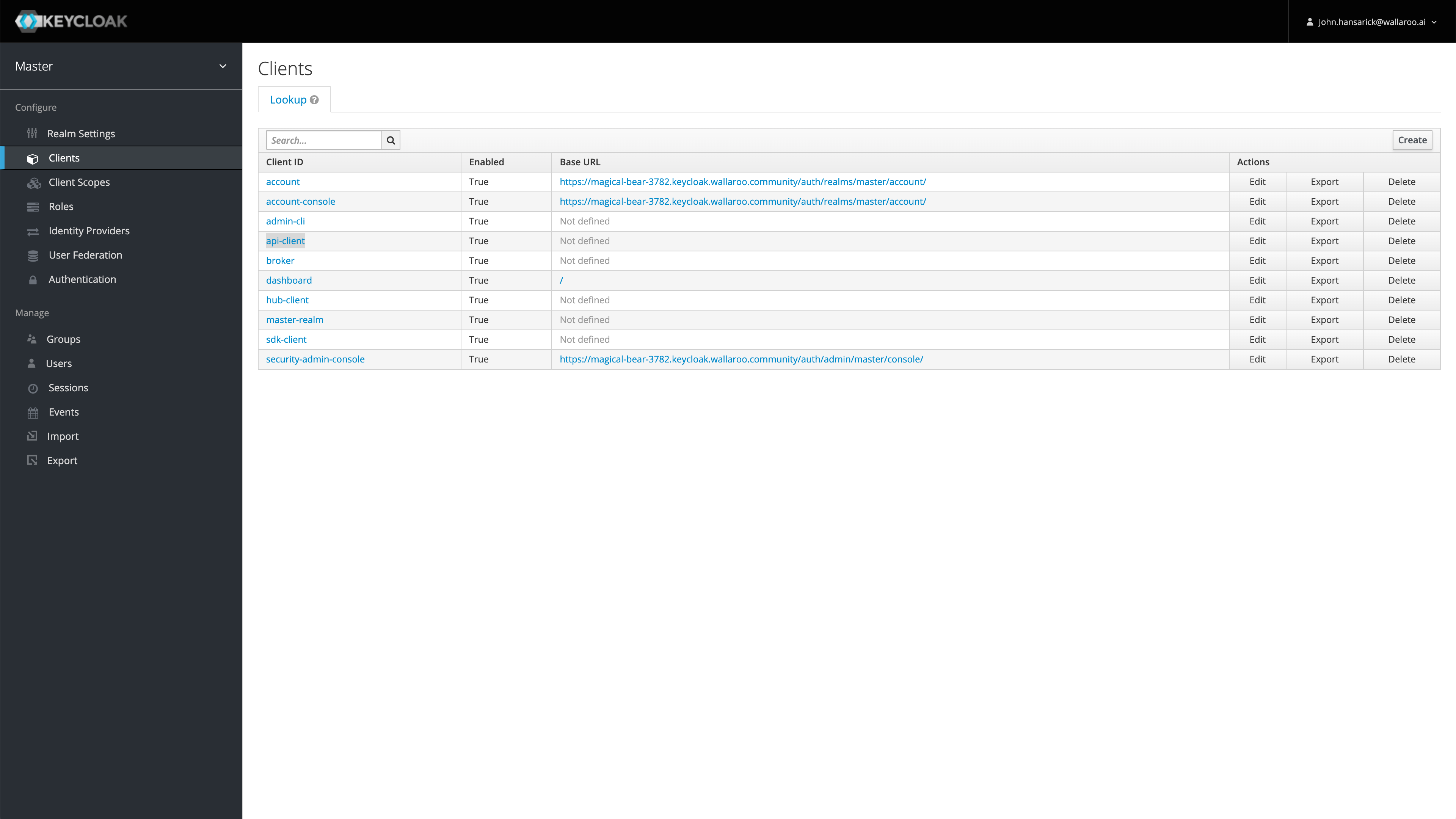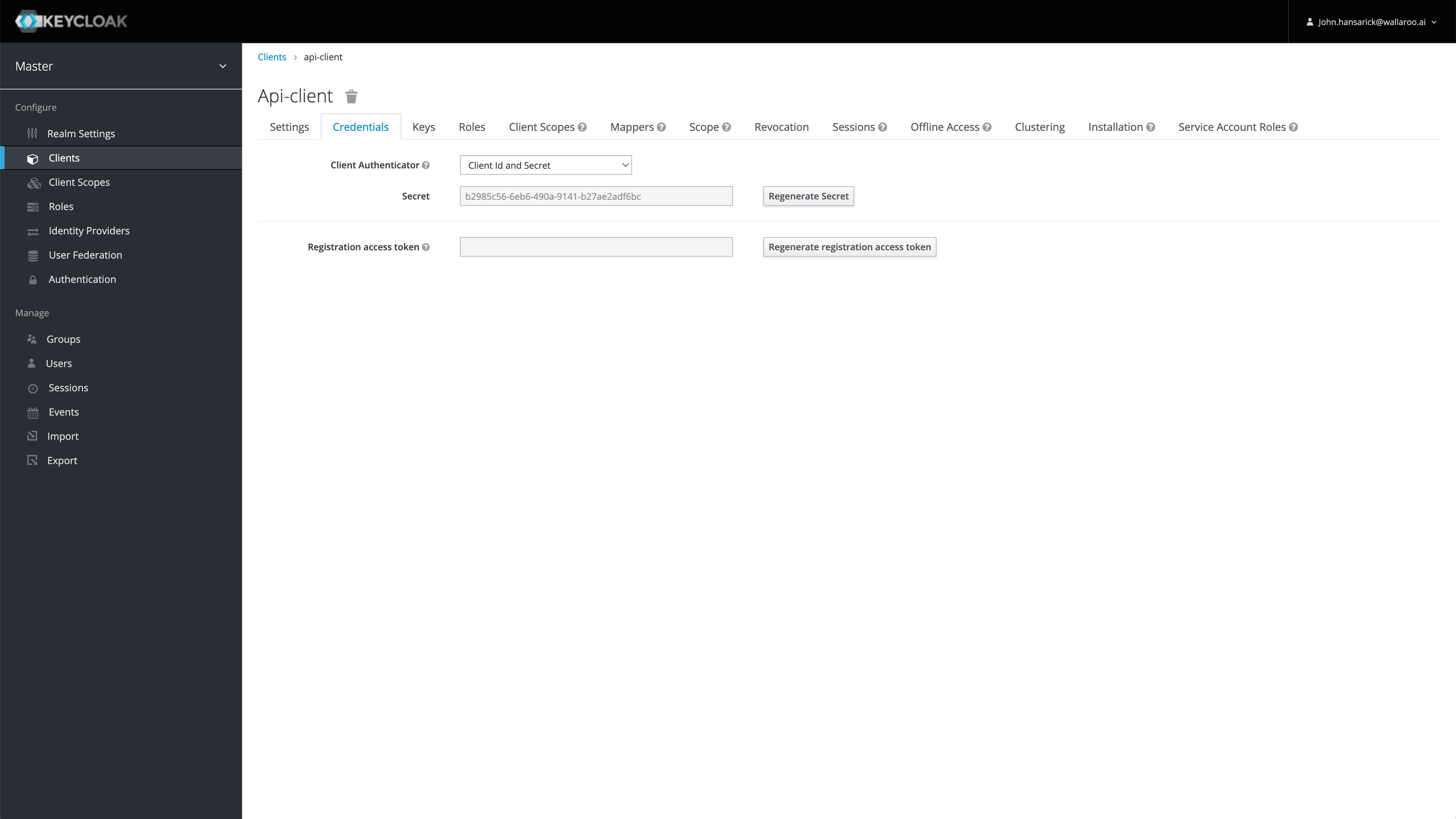Wallaroo MLOps API Essentials Guide: User Management
How to use the Wallaroo API for User Management
This tutorial and the assets are available as part of the Wallaroo Tutorials repository.
The Wallaroo MLOps API allows organizations to submit requests to their Wallaroo instance to perform such actions as:
The following examples will show how to submit queries to the Wallaroo MLOps API and the types of responses returned.
The following references are available for more information about Wallaroo and the Wallaroo MLOps API:
https://{Wallaroo Prefix.}api.{Wallaroo Suffix}/v1/api/docs. For example, if the Wallaroo Instance suffix is example.wallaroo.ai with the prefix {lovely-rhino-5555.}, then the Wallaroo MLOps API Documentation would be available at https://lovely-rhino-5555.api.example.wallaroo.ai/v1/api/docs. Note the . is part of the prefix.wallaroo.example.wallaroo.ai, the the Wallaroo MLOps API Documentation would be available at https://api.wallaroo.example.wallaroo.ai/v1/api/docs. For more information, see the Wallaroo Documentation Site.IMPORTANT NOTE: The Wallaroo MLOps API is provided as an early access features. Future iterations may adjust the methods and returns to provide a better user experience. Please refer to this guide for updates.
requestsjsonwallaroo: The Wallaroo SDK. Included with the Wallaroo JupyterHub service by default.pandas: Pandas, mainly used for Pandas DataFrame. Included with the Wallaroo JupyterHub service by default.pyarrow: PyArrow for Apache Arrow support. Included with the Wallaroo JupyterHub service by default.polars: Polars for DataFrame with native Apache Arrow supportThe following demonstrates how to use each command in the Wallaroo MLOps API, and can be modified as best fits your organization’s needs.
For the examples, the Python requests library will be used to make the REST HTTP(S) connections.
import wallaroo
from wallaroo.object import EntityNotFoundError
import pandas as pd
import os
import pyarrow as pa
import requests
from requests.auth import HTTPBasicAuth
import json
# used to display dataframe information without truncating
from IPython.display import display
pd.set_option('display.max_colwidth', None)
The following guide was established with set names for workspaces, pipelines, and models. Note that some commands, such as creating a workspace, will fail if another workspace is already created with the same name. Similar, if a user is already established with the same email address as in the examples below, etc.
To reduce errors, the following variables are declared. Please change them as required to avoid issues in an established Wallaroo environment.
For wallarooPrefix = "YOUR PREFIX." and wallarooSuffix = "YOUR SUFFIX", enter the prefix and suffix for your Wallaroo instance DNS name. If the prefix instance is blank, then it can be wallarooPrefix = "". Note that the prefix includes the . for proper formatting.
## Sample Variables List
new_user = "john.hansarick@wallaroo.ai"
new_user_password = "Snugglebunnies"
example_workspace_name = "apiworkspaces"
model_name = "apimodel"
model_file_name = "./models/ccfraud.onnx"
stream_model_name = "apiteststreammodel"
stream_model_file_name = "./models/ccfraud.onnx"
empty_pipeline_name="pipelinenomodel"
model_pipeline_name="pipelinemodels"
example_copied_pipeline_name="copiedmodelpipeline"
wallarooPrefix = "YOUR PREFIX."
wallarooSuffix = "YOUR SUFFIX"
# Retrieving login data through credential file
f = open('./creds.json')
login_data = json.load(f)
Wallaroo comes pre-installed with a confidential OpenID Connect client. The default client is api-client, but other clients may be created and configured.
Confidential clients require its secret to be supplied when requesting a token. Administrators may obtain their API client credentials from Keycloak from the Keycloak Service URL as listed above and the prefix /auth/admin/master/console/#/realms/master/clients.
For example, if the Wallaroo DNS address is in the format https://{WALLAROO PREFIX.}{WALLAROO SUFFIX}, then the direct path to the Keycloak API client credentials would be:
https://{WALLAROO PREFIX.}keycloak.{WALLAROO SUFFIX}/auth/admin/master/console/#/realms/master/clients
If the there is no prefix, then the address would simply be:
https://keycloak.{WALLAROO SUFFIX}/auth/admin/master/console/#/realms/master/clients
Then select the client, in this case api-client, then Credentials.


By default, tokens issued for api-client are valid for up to 60 minutes. Refresh tokens are supported.
There are two tokens used with Wallaroo API services:
MLOps tokens: User tokens are generated with the confidential client credentials and the username/password of the Wallaroo user making the MLOps API request and requires:
The Wallaroo instance Keycloak address.
The confidential client, api-client by default.
The confidential client secret.
The Wallaroo username making the MLOps API request.
The Wallaroo user’s password.
This request return includes the access_token and the refresh_token. The access_token is used to authenticate. The refresh_token can be used to create a new token without submitting the original username and password.
A sample curl version of that request is:
eval $(curl "https://${URL_PREFIX}keycloak.${URL_SUFFIX}/auth/realms/master/protocol/openid-connect/token" -u "${CONFIDENTIAL_CLIENT}:${CONFIDENTIAL_CLIENT_SECRET}" -d "grant_type=password&username=${USERNAME}&password=${PASSWORD}&scope=offline_access' -s | jq -r '"TOKEN=\(.access_token) REFRESH=\(.refresh_token)"')
The confidential client, api-client by default.
The confidential client secret.
The refresh token retrieved from the initial access token request. A curl version of that request is:
TOKEN=$(curl "https://${URL_PREFIX}keycloak.${URL_SUFFIX}/auth/realms/master/protocol/openid-connect/token" -u "${CONFIDENTIAL_CLIENT}:${CONFIDENTIAL_CLIENT_SECRET}" -d "grant_type=refresh_token&refresh_token=${REFRESH}" -s | jq -r '.access_token')
Inference Token: Tokens used as part of a Pipeline Inference URL request. These do not require a Wallaroo user credentials. Inference token request require the following:
The Wallaroo instance Keycloak address.
The confidential client, api-client by default.
The confidential client secret.
A curl version of that command is:
TOKEN=$(curl "https://${URL_PREFIX}keycloak.${URL_SUFFIX}/auth/realms/master/protocol/openid-connect/token" -u "${CONFIDENTIAL_CLIENT}:${CONFIDENTIAL_CLIENT_SECRET}" -d 'grant_type=client_credentials' -s | jq -r '.access_token')
The following examples demonstrate:
The username and password for the user are stored in the file ./creds.json to prevent them from being displayed in a demonstration.
## Generating token with confidential client, client secret, username, password
TOKENURL=f'https://{wallarooPrefix}keycloak.{wallarooSuffix}/auth/realms/master/protocol/openid-connect/token'
USERNAME = login_data["username"]
PASSWORD = login_data["password"]
CONFIDENTIAL_CLIENT=login_data["confidentialClient"]
CONFIDENTIAL_CLIENT_SECRET=login_data["confidentialPassword"]
auth = HTTPBasicAuth(CONFIDENTIAL_CLIENT, CONFIDENTIAL_CLIENT_SECRET)
data = {
'grant_type': 'password',
'username': USERNAME,
'password': PASSWORD
}
response = requests.post(TOKENURL, auth=auth, data=data, verify=True)
access_token = response.json()['access_token']
refresh_token = response.json()['refresh_token']
display(access_token)
'eyJhbGciOiJSUzI1NiIsInR5cCIgOiAiSldUIiwia2lkIiA6ICJDYkFqN19QY0xCWTFkWmJiUDZ6Q3BsbkNBYTd6US0tRHlyNy0yLXlQb25nIn0.eyJleHAiOjE2ODQzNjAxNjUsImlhdCI6MTY4NDM1NjU2NSwianRpIjoiZGQxMDFkODMtMzk5ZC00N2M2LThlZDMtNjQxMGRmNThhYmViIiwiaXNzIjoiaHR0cHM6Ly9kb2MtdGVzdC5rZXljbG9hay53YWxsYXJvb2NvbW11bml0eS5uaW5qYS9hdXRoL3JlYWxtcy9tYXN0ZXIiLCJhdWQiOlsibWFzdGVyLXJlYWxtIiwiYWNjb3VudCJdLCJzdWIiOiIwMjhjOGI0OC1jMzliLTQ1NzgtOTExMC0wYjViZGQzODI0ZGEiLCJ0eXAiOiJCZWFyZXIiLCJhenAiOiJhcGktY2xpZW50Iiwic2Vzc2lvbl9zdGF0ZSI6Ijk4MDhkZTA5LWU2NjYtNGIyNC05ZWQ4LTc2MmUxZjllODk0ZSIsImFjciI6IjEiLCJhbGxvd2VkLW9yaWdpbnMiOlsiKiJdLCJyZWFsbV9hY2Nlc3MiOnsicm9sZXMiOlsiZGVmYXVsdC1yb2xlcy1tYXN0ZXIiLCJvZmZsaW5lX2FjY2VzcyIsInVtYV9hdXRob3JpemF0aW9uIl19LCJyZXNvdXJjZV9hY2Nlc3MiOnsibWFzdGVyLXJlYWxtIjp7InJvbGVzIjpbIm1hbmFnZS11c2VycyIsInZpZXctdXNlcnMiLCJxdWVyeS1ncm91cHMiLCJxdWVyeS11c2VycyJdfSwiYWNjb3VudCI6eyJyb2xlcyI6WyJtYW5hZ2UtYWNjb3VudCIsIm1hbmFnZS1hY2NvdW50LWxpbmtzIiwidmlldy1wcm9maWxlIl19fSwic2NvcGUiOiJwcm9maWxlIGVtYWlsIiwic2lkIjoiOTgwOGRlMDktZTY2Ni00YjI0LTllZDgtNzYyZTFmOWU4OTRlIiwiZW1haWxfdmVyaWZpZWQiOmZhbHNlLCJodHRwczovL2hhc3VyYS5pby9qd3QvY2xhaW1zIjp7IngtaGFzdXJhLXVzZXItaWQiOiIwMjhjOGI0OC1jMzliLTQ1NzgtOTExMC0wYjViZGQzODI0ZGEiLCJ4LWhhc3VyYS1kZWZhdWx0LXJvbGUiOiJ1c2VyIiwieC1oYXN1cmEtYWxsb3dlZC1yb2xlcyI6WyJ1c2VyIl0sIngtaGFzdXJhLXVzZXItZ3JvdXBzIjoie30ifSwibmFtZSI6IkpvaG4gSGFuc2FyaWNrIiwicHJlZmVycmVkX3VzZXJuYW1lIjoiam9obi5odW1tZWxAd2FsbGFyb28uYWkiLCJnaXZlbl9uYW1lIjoiSm9obiIsImZhbWlseV9uYW1lIjoiSGFuc2FyaWNrIiwiZW1haWwiOiJqb2huLmh1bW1lbEB3YWxsYXJvby5haSJ9.lfesLVvWM21kbWIhQtT2ap-ruT5_qt7CVcPUt1mAS8KoksuiJIb4QxPV9FwGB1I7sPiWjXR60cR-cjNLLoTgCX9GZZbfISDR4NvqN5ZBANDzYCx64WtTZCaDPeWROClHvmmE6Mfs1mAdgC3fIxkDe6Ns5-S6wnDqW7v6-yaNo5gBywftaCFyD3lFsmpmBvcyXphtn7sUlX_W4Ku9xmaalUkLv1F8528thZAARN5Jl-_uTHNKCe5wYGiEpQkbeIZ_Rjzqnctx-onw3cVKgbS6_wATr0TZQxgR2AY459OkCJ3rcuJTTTI5PihEGKlQUX5GmDIGG8DqE3iAPJ-xCY-OBQ'
## Refresh the token
TOKENURL=f'https://{wallarooPrefix}keycloak.{wallarooSuffix}/auth/realms/master/protocol/openid-connect/token'
# Retrieving through os environmental variables
f = open('./creds.json')
login_data = json.load(f)
CONFIDENTIAL_CLIENT=login_data["confidentialClient"]
CONFIDENTIAL_CLIENT_SECRET=login_data["confidentialPassword"]
auth = HTTPBasicAuth(CONFIDENTIAL_CLIENT, CONFIDENTIAL_CLIENT_SECRET)
data = {
'grant_type': 'refresh_token',
'refresh_token': refresh_token
}
response = requests.post(TOKENURL, auth=auth, data=data, verify=True)
access_token = response.json()['access_token']
refresh_token = response.json()['refresh_token']
display(access_token)
'eyJhbGciOiJSUzI1NiIsInR5cCIgOiAiSldUIiwia2lkIiA6ICJDYkFqN19QY0xCWTFkWmJiUDZ6Q3BsbkNBYTd6US0tRHlyNy0yLXlQb25nIn0.eyJleHAiOjE2ODQzNjAxNjcsImlhdCI6MTY4NDM1NjU2NywianRpIjoiZDJlNTNlNzEtYjYzMi00MzNmLThjY2UtOGIxMDI0ZjFmYzliIiwiaXNzIjoiaHR0cHM6Ly9kb2MtdGVzdC5rZXljbG9hay53YWxsYXJvb2NvbW11bml0eS5uaW5qYS9hdXRoL3JlYWxtcy9tYXN0ZXIiLCJhdWQiOlsibWFzdGVyLXJlYWxtIiwiYWNjb3VudCJdLCJzdWIiOiIwMjhjOGI0OC1jMzliLTQ1NzgtOTExMC0wYjViZGQzODI0ZGEiLCJ0eXAiOiJCZWFyZXIiLCJhenAiOiJhcGktY2xpZW50Iiwic2Vzc2lvbl9zdGF0ZSI6Ijk4MDhkZTA5LWU2NjYtNGIyNC05ZWQ4LTc2MmUxZjllODk0ZSIsImFjciI6IjEiLCJhbGxvd2VkLW9yaWdpbnMiOlsiKiJdLCJyZWFsbV9hY2Nlc3MiOnsicm9sZXMiOlsiZGVmYXVsdC1yb2xlcy1tYXN0ZXIiLCJvZmZsaW5lX2FjY2VzcyIsInVtYV9hdXRob3JpemF0aW9uIl19LCJyZXNvdXJjZV9hY2Nlc3MiOnsibWFzdGVyLXJlYWxtIjp7InJvbGVzIjpbIm1hbmFnZS11c2VycyIsInZpZXctdXNlcnMiLCJxdWVyeS1ncm91cHMiLCJxdWVyeS11c2VycyJdfSwiYWNjb3VudCI6eyJyb2xlcyI6WyJtYW5hZ2UtYWNjb3VudCIsIm1hbmFnZS1hY2NvdW50LWxpbmtzIiwidmlldy1wcm9maWxlIl19fSwic2NvcGUiOiJwcm9maWxlIGVtYWlsIiwic2lkIjoiOTgwOGRlMDktZTY2Ni00YjI0LTllZDgtNzYyZTFmOWU4OTRlIiwiZW1haWxfdmVyaWZpZWQiOmZhbHNlLCJodHRwczovL2hhc3VyYS5pby9qd3QvY2xhaW1zIjp7IngtaGFzdXJhLXVzZXItaWQiOiIwMjhjOGI0OC1jMzliLTQ1NzgtOTExMC0wYjViZGQzODI0ZGEiLCJ4LWhhc3VyYS1kZWZhdWx0LXJvbGUiOiJ1c2VyIiwieC1oYXN1cmEtYWxsb3dlZC1yb2xlcyI6WyJ1c2VyIl0sIngtaGFzdXJhLXVzZXItZ3JvdXBzIjoie30ifSwibmFtZSI6IkpvaG4gSGFuc2FyaWNrIiwicHJlZmVycmVkX3VzZXJuYW1lIjoiam9obi5odW1tZWxAd2FsbGFyb28uYWkiLCJnaXZlbl9uYW1lIjoiSm9obiIsImZhbWlseV9uYW1lIjoiSGFuc2FyaWNrIiwiZW1haWwiOiJqb2huLmh1bW1lbEB3YWxsYXJvby5haSJ9.Va5OiLkedj-mFuI7UhsxXshmaSbhXthLv-PU56f2JiQi5-wiWXXxRk3pUioavIzKbi-VjmYQfbR95VY5QSWpUuD3scPuRhHDkSeslz6390phYiFygK_PmXMviQnL2q1mwdGzwh69htOjUWLf7MGWjNmkNdzjYyBy8gfD3V2O2MCfN3onVVCqr1aA1aAQXe9y_JswhjooxAQGit1xzNicvm3IW3QhHtOrDKj7gXNuSlc5vKqe52RQYEgElltqIOV4PVe12UGthKMfvdlDIeUEpTzXVFRH8XHJCrO_YQ_W9m-Rt1_9kelBl3SksdYKOisZaGwo6lv7hhapembH0iD29Q'
## Pipeline Inference URL token - does not require Wallaroo username/password.
TOKENURL=f'https://{wallarooPrefix}keycloak.{wallarooSuffix}/auth/realms/master/protocol/openid-connect/token'
# Retrieving through os environmental variables
f = open('./creds.json')
login_data = json.load(f)
CONFIDENTIAL_CLIENT=login_data["confidentialClient"]
CLIENT_SECRET=login_data["confidentialPassword"]
auth = HTTPBasicAuth(CONFIDENTIAL_CLIENT, CLIENT_SECRET)
data = {
'grant_type': 'client_credentials'
}
response = requests.post(TOKENURL, auth=auth, data=data, verify=True)
inference_access_token = response.json()['access_token']
display(inference_access_token)
'eyJhbGciOiJSUzI1NiIsInR5cCIgOiAiSldUIiwia2lkIiA6ICJDYkFqN19QY0xCWTFkWmJiUDZ6Q3BsbkNBYTd6US0tRHlyNy0yLXlQb25nIn0.eyJleHAiOjE2ODQzNjAxNjgsImlhdCI6MTY4NDM1NjU2OCwianRpIjoiNjIyOTViYmUtYzVlMi00NDQ2LWFmMDctNzY5MDAwNmI2NzI3IiwiaXNzIjoiaHR0cHM6Ly9kb2MtdGVzdC5rZXljbG9hay53YWxsYXJvb2NvbW11bml0eS5uaW5qYS9hdXRoL3JlYWxtcy9tYXN0ZXIiLCJhdWQiOlsibWFzdGVyLXJlYWxtIiwiYWNjb3VudCJdLCJzdWIiOiJmNmI5ODg5NC1iZTVjLTQyZDUtYTZhNS02ZjE5ZTY1YmNiNGEiLCJ0eXAiOiJCZWFyZXIiLCJhenAiOiJhcGktY2xpZW50IiwiYWNyIjoiMSIsImFsbG93ZWQtb3JpZ2lucyI6WyIqIl0sInJlYWxtX2FjY2VzcyI6eyJyb2xlcyI6WyJkZWZhdWx0LXJvbGVzLW1hc3RlciIsIm9mZmxpbmVfYWNjZXNzIiwidW1hX2F1dGhvcml6YXRpb24iXX0sInJlc291cmNlX2FjY2VzcyI6eyJtYXN0ZXItcmVhbG0iOnsicm9sZXMiOlsiaW1wZXJzb25hdGlvbiIsIm1hbmFnZS11c2VycyIsInZpZXctdXNlcnMiLCJxdWVyeS1ncm91cHMiLCJxdWVyeS11c2VycyJdfSwiYWNjb3VudCI6eyJyb2xlcyI6WyJtYW5hZ2UtYWNjb3VudCIsIm1hbmFnZS1hY2NvdW50LWxpbmtzIiwidmlldy1wcm9maWxlIl19fSwic2NvcGUiOiJwcm9maWxlIGVtYWlsIiwiZW1haWxfdmVyaWZpZWQiOmZhbHNlLCJjbGllbnRJZCI6ImFwaS1jbGllbnQiLCJjbGllbnRIb3N0IjoiMTAuMjQ0LjEuNzQiLCJodHRwczovL2hhc3VyYS5pby9qd3QvY2xhaW1zIjp7IngtaGFzdXJhLXVzZXItaWQiOiJmNmI5ODg5NC1iZTVjLTQyZDUtYTZhNS02ZjE5ZTY1YmNiNGEiLCJ4LWhhc3VyYS1kZWZhdWx0LXJvbGUiOiJ1c2VyIiwieC1oYXN1cmEtYWxsb3dlZC1yb2xlcyI6WyJ1c2VyIl0sIngtaGFzdXJhLXVzZXItZ3JvdXBzIjoie30ifSwicHJlZmVycmVkX3VzZXJuYW1lIjoic2VydmljZS1hY2NvdW50LWFwaS1jbGllbnQiLCJjbGllbnRBZGRyZXNzIjoiMTAuMjQ0LjEuNzQifQ.fde1-NsmXqCen71sRcIarscK1j4oFGATf8jh834aAUSb_UGXEmxEnUDDGMegu7KmpbeOi2ogIGY0ndACaZqS21lvVpzWHyVdsQGXCtl1mjwgLt0kzq6U5uR8znMIV-2Babw-9eE65F9I3TdUKRlnh8J5SAPvbOj_Hv_Y3u4cNj1b_Hk_o9lAEg-m2V0ZL7UDxgnVyitbWChiP4DE3q6yBBSVoORiBXDrfUiwIpCXyVKJIO_HrowEA8bYVOhh8PcbywmVa1kZaPcMuAOzsaysE361NCvJqbikVf4KX5Ii9k7lk90v3c-9VX24bIC67HFG8TwvWVnKRBAawwXcQ2ZTIA'
The Wallaroo SDK method Wallaroo Client wl.auth.auth_header() method provides the token with the Authorization header.
# Retrieve the token
headers = wl.auth.auth_header()
display(headers)
{'Authorization': 'Bearer abcdefg'}
For this example, a connection to the Wallaroo SDK is used. This will be used to retrieve the JWT token for the MLOps API calls.
This example will store the user’s credentials into the file ./creds.json which contains the following:
{
"username": "{Connecting User's Username}",
"password": "{Connecting User's Password}",
"email": "{Connecting User's Email Address}"
}
Replace the username, password, and email fields with the user account connecting to the Wallaroo instance. This allows a seamless connection to the Wallaroo instance and bypasses the standard browser based confirmation link. For more information, see the Wallaroo SDK Essentials Guide: Client Connection.
For wallarooPrefix = "YOUR PREFIX." and wallarooSuffix = "YOUR SUFFIX", enter the prefix and suffix for your Wallaroo instance DNS name. If the prefix instance is blank, then it can be wallarooPrefix = "". Note that the prefix includes the . for proper formatting.
# Retrieve the login credentials.
os.environ["WALLAROO_SDK_CREDENTIALS"] = './creds.json'
# Client connection from local Wallaroo instance
wallarooPrefix = "YOUR PREFIX."
wallarooSuffix = "YOUR SUFFIX"
wl = wallaroo.Client(api_endpoint=f"https://{wallarooPrefix}api.{wallarooSuffix}",
auth_endpoint=f"https://{wallarooPrefix}keycloak.{wallarooSuffix}",
auth_type="user_password")
The variable APIURL is used to specify the connection to the Wallaroo instance’s MLOps API URL.
APIURL=f"https://{wallarooPrefix}api.{wallarooSuffix}"
This tutorial relies on the Python requests library, and the Wallaroo Wallaroo Client wl.auth.auth_header() method.
MLOps API requests are always POST. Most are submitted with the header 'Content-Type':'application/json' unless specified otherwise.
How to use the Wallaroo API for User Management
How to use the Wallaroo API for Workspace Management
How to use the Wallaroo API for Model Management
How to use the Wallaroo API for Model Registry aka Artifact Registries
How to use the Wallaroo API to upload models of different frameworks.
How to use the Wallaroo API for Pipeline Management
How to use the Wallaroo API for Pipeline Log Management
How to use the Wallaroo API for Enablement Management
How to use the Wallaroo API for Assays Management
How to use the Wallaroo API for Connections Management
How to use the Wallaroo API for ML Workload Orchestration Management
How to use Wallaroo MLOps Api for inferencing